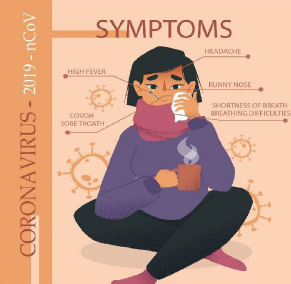Symptoms, Diagnosis & How dangerous is 2019-nCoV?
There can be a range of symptoms from mild to severe, include fever and respiratory symptoms
such as shortness of breath and coughing. There has been kidney failure, pneumonia and death in more
severe cases.
Diagnosis
How can we tell if someone has the 2019-nCoV?
It can be a difficult to identify the disease bases on the symptoms only because the illness cause by
the 2019-nCoV is very similar to a cold or flu. That is why it requires laboratory tests on respiratory
specimens as well as blood test and blest work to confirm if someone is infected with the 2019-nCoV.
The test called PCR (Polymerase Chain Reaction) will identify the virus based on its genetic
fingerprint.
How dangerous is 2019-nCoV?
What actually happens if you get coronavirus?
Once the virus is able to invade your body, its work can begin. The virus binds to receptors on the
cell once it comes in contact with that cell. The virus’s outer layer of the virus is like a key and it can
unlock the right cells in the right pieces. The virus, as a result, is able to get into and has access to all
the cells machinery.
This system is normally reserved for your DNA to produce protein with all sorts of functions and
bring it through all over your body but the coronavirus hijacks this system and make proteins that it
wants using its own ARN. Basically, your cells start making viruses with genetic material, the capsid
and the envelope and ultimately it turns into a virus making machine. The RNA instruction of the virus
reads over and over again and produce protein after protein. Ultimately it can produce millions of
viruses. They will eventually fill and destroy the cell then it moves on to the other cells and repeat the
cycle all over again.
In a healthy individual, once your cells start to be damaged and die, the immune system in your
body will sense this and trigger an immune response to mount an attack. All the symptoms that you
feel is the result of this. The body increase its temperature to help the immune system functions better
and create a hostile environment for the virus. There may be more phlegm and snot to prevent the
virus from attaching to your cells and help remove the dead viruses. Your body will prioritize fighting
off the virus instead of doing its regular function so you may feel tired and weak.
However, death is not always caused by the virus. When your immune system is distracted and
weakened, bacteria and other organisms can take advantage and make it more complicated. The
whole body can shut down if the organs start to shut down.
How dangerous is 2019-nCoV compared with MERS-CoV and SARS-CoV?
The 2019-nCoV along with MERS-CoV and MARS-CoV are the identified coronaviruses that
evolve and have the ability to infect human and spread among humans. The table below will help you
have a better look at the similarity as well as the difference between these 3 types of human
coronaviruses, especially to help you aware how dangerous 2019-nCoV is compared to the other
viruses in the same family.
Fatality Rate/ Death Rate:
The new
From the analysis, it shows that 2/3 of death cases are male, 1/3 is female. It is mainly elderly
Transmission Rate (R0): The transmissibility (how rapidly the disease spreads) or attack rate of a
virus is indicated by its reproductive number (R0, pronounced r-zero R-nought), which shows the
average number of people whom a single infected person will transmit to. R0 is estimated to be
between 1.5 and 3.5 preliminary studies according to Worldometer.
Based on these statistics, each case of the 2019-nCoV would make 3 to 4 new cases on average.
Incubation Period: The incubation period is the time between infection and the onset of clinical
symptoms of disease. It is reported an incubation period for 2019-nCoV between 2 – 14 days with the
average of 5.2 days and this number can greatly vary between patients.
A study of this case indicated that the incubation period tended to be shorter among people of 70
year old or above, which is between 6-19 days (11.5 days on average) than those with ages under 70
year old, which is 10-41 days (20 days on average).

